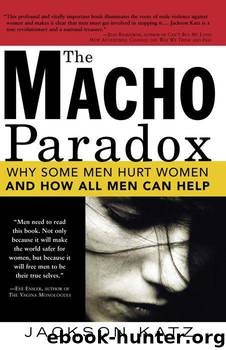Macho Paradox: Why Some Men Hurt Women and and How All Men Can Help by Katz Jackson

Author:Katz, Jackson [Katz, Jackson]
Language: eng
Format: mobi
Publisher: Sourcebooks
Published: 2006-03-31T16:00:00+00:00
LAKERS FANS SEND A MESSAGE
There is nothing like the rape trial of a famous athlete to remind us of how far we have yet to come in our understanding of sexual violence. The antirape movement has accomplished many things over the past three decades in the areas of legal reform, professional training for police, prosecutors, and judges, and public awareness. Arguably the movement’s greatest contribution has been to victim services. In most parts of this country, rape victims today can count on a level of compassionate, professional support that is historically unprecedented—and which still does not exist in many other countries. In spite of these positive changes, however, the explosion of victim-blaming unleashed in the aftermath of the sexual-assault charge against Kobe Bryant came as an unexpected wake-up call to many in the anti-rape movement who had been working for years to establish the seemingly straightforward idea that in rape cases the alleged perpetrator is the one on trial—not the victim. Almost from the moment that Bryant’s alleged victim—a nineteenyear-old college student—reported that he had raped her in his hotel room at a mountain resort in Eagle, Colorado, people on sports talk programs and around office water coolers began to impugn her morality and question her mental stability, character, and sexual practices. Instead of focusing attention on the behavior, character, and motive of the basketball superstar who was alleged to have raped her, people asked questions like: Why did she go up to his room? Didn’t she know what to expect?
Public opinion did not just question the victim; it also actively supported the alleged perpetrator. Consider this sequence of events. When Kobe Bryant appeared on a basketball court in Colorado on January 7, 2004, for a game against the Denver Nuggets, the media focus before and after the event was on the fans’ response. How loud would the boos be? Would they distract the Laker star to the point of disrupting his game? Was it possible for the authorities to ensure his safety? The Denver fans did not disappoint. Many at the Pepsi Center booed loudly, not only when he was introduced, but every time he touched the ball. It is not surprising that an athlete in the midst of a criminal trial would receive a chilly reception on the road. Especially when he was alleged to have raped a woman in the local area. But the more revealing aspect of the fan response to the Bryant case occurred at the Staples Center in Los Angeles a couple of weeks before and repeated itself several times in the subsequent months. On December 19, 2003, the Laker superstar arrived late for a home game, coincidentally also against Denver. He was late because earlier in the day he had to appear at a court hearing in Colorado; he flew back on a private jet in time to enter the game early in the second quarter. When Bryant emerged from the locker room and made his way over to the Lakers bench, thousands of cheering people sprang to their feet.
Download
This site does not store any files on its server. We only index and link to content provided by other sites. Please contact the content providers to delete copyright contents if any and email us, we'll remove relevant links or contents immediately.
| General | Men |
| Women in History |
Cecilia; Or, Memoirs of an Heiress — Volume 1 by Fanny Burney(32495)
Cecilia; Or, Memoirs of an Heiress — Volume 2 by Fanny Burney(31909)
Cecilia; Or, Memoirs of an Heiress — Volume 3 by Fanny Burney(31892)
The Great Music City by Andrea Baker(31756)
We're Going to Need More Wine by Gabrielle Union(19003)
All the Missing Girls by Megan Miranda(15773)
Pimp by Iceberg Slim(14433)
Bombshells: Glamour Girls of a Lifetime by Sullivan Steve(14020)
For the Love of Europe by Rick Steves(13558)
Talking to Strangers by Malcolm Gladwell(13290)
Norse Mythology by Gaiman Neil(13278)
Fifty Shades Freed by E L James(13186)
Mindhunter: Inside the FBI's Elite Serial Crime Unit by John E. Douglas & Mark Olshaker(9260)
Crazy Rich Asians by Kevin Kwan(9220)
The Lost Art of Listening by Michael P. Nichols(7453)
Enlightenment Now: The Case for Reason, Science, Humanism, and Progress by Steven Pinker(7272)
The Four Agreements by Don Miguel Ruiz(6698)
Bad Blood by John Carreyrou(6581)
Weapons of Math Destruction by Cathy O'Neil(6214)
